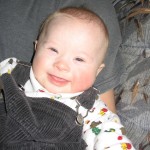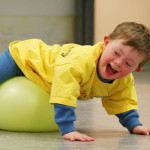The first years of life are a critical time in a child’s development. All young children go through the most rapid and developmentally significant changes during this time. During these early years, they achieve the basic physical, cognitive, language, social and self-help skills that lay the foundation for future progress and these abilities are attained according to predictable developmental patterns. Children with Down syndrome typically face delays in certain areas of development, so early intervention is highly recommended. It can begin anytime after birth, but the sooner it starts the better.
What is Early Intervention?
Early intervention is a systematic program of therapy, exercises and activities designed to address developmental delays that may be experienced by children with Down syndrome or other disabilities with the goal of enhancing the development of infants and toddlers and helping families understand and meet the needs of their children. The most common early intervention services for babies with Down syndrome are physical therapy, speech and language therapy, and occupational therapy.
When Should Early Intervention Start?
Early Intervention should begin any time shortly after birth, and usually continues until the child enters, or is eligible to enter, kindergarten. The sooner early intervention begins, the better, however, it’s never too late to start.
How Can Early Intervention Help a Child with Down syndrome?
Development is a continuous process that begins at conception and proceeds stage by stage in an orderly sequence. There are specific milestones in each of the four areas of development (gross and fine motor abilities, language skills, social development and self-help skills) that serve as prerequisites for the stages that follow. Most children are expected to achieve each milestone at a designated time, also referred to as a “key age,” which can be calculated in terms of weeks, months or years. Because of specific challenges associated with Down syndrome, babies will likely experience delays in certain areas of development. However, they will achieve each of the same milestones as other children, just on their own timetable. In monitoring the development of a child with Down syndrome, it is more useful to look at the sequence of milestones achieved, rather than the age at which the milestone is reached.
What are the Types of Early Intervention Therapies and How Does Each Type Address Specific Aspects of a Baby’s Development?
Physical therapy focuses on motor development. For example, during the first three to four months of life, an infant is expected to gain head control and the ability to pull to a sitting positions (with help) with no head lags and enough strength in the upper torso to maintain an erect posture. Appropriate physical therapy may assist a baby with Down syndrome, who may have low muscle tone, in achieving this milestone.
Before birth and in the first months of life, physical development remains the underlying foundation for all future progress. Babies learn through interaction with their environment. In order to do so, an infant must have the ability to move freely and purposefully. The ability to explore one’s surroundings, the ability to reach and grasp toys, to turn one’s head in order to follow a moving object with one’s eyes, the ability to roll over, to crawl in pursuit of a desired objective, all of these behaviours are dependent upon gross as well as fine motor development. These physical, interactive activities foster understanding and mastery of the environment, stimulating cognitive, language and social development.
Another long term benefit of physical therapy is that it helps prevent compensatory movement patterns that individuals with Down syndrome are prone to developing. This can lead to orthopaedic and functional problems if not corrected.
Speech and language therapy is a critical component of early intervention. Even though babies with Down syndrome may not say first words until 2 or 3 years of age, there are many pre-speech and pre-language skills that must be acquired first. These include the ability to imitate and echo sounds; turn taking skills (learned through games like “peek-a-boo”); visual skills (looking at the speaker and objects); auditory skills (listening to music and speech for lengthening periods of time, or listening to speech sounds); tactile skills (learning about touch, exploring objects in the mouth); oral motor skills (using the tongue, moving the lips); and cognitive skills (understanding object permanence, and cause and effect relationships).
A speech and language therapist can help with these and other skills, including breastfeeding. Because breastfeeding employs the same anatomical structures used for speech, it can help strengthen a baby’s jaw and facial muscles and lay the foundation for future communication skills.
Occupational therapy helps children develop and master skills for independence. Occupational therapy can help with abilities such as opening and closing things, picking up and releasing toys of various sizes and shapes, stacking and building, manipulating knobs and buttons, experimenting with crayons etc. Therapists also help children learn to feed and dress themselves, and teach skills for playing and interacting with other children.
Early intervention can also prevent a child with Down syndrome from reaching a plateau at some point in development. Thus, the goal of early intervention programs is to enhance and accelerate development by building on a child’s strengths and by strengthening those areas that are weaker, in all areas of development.
How Can Parents Benefit From Early Intervention Programs
Programs of early intervention have a great deal to offer to parents in terms of support, encouragement and information. The programs teach parents how to interact with their infant and toddler, how to meet their child’s specific needs and how to enhance development.
How Do I Access Early Intervention Services?
Here in the FraserValley, the baby’s doctor will put in a referral to the Child Development Centre who will contact the parents about starting services. Once a referral has been made, staff from the Infant Development Program will schedule a time to meet with the parents and child. Early intervention services are individualized to meet the specific needs of each individual baby. The consultant, therapists and family will determine the areas of focus and set goals based on the developmental milestones.
What Happens After Age 5?
Once the child enters, or is eligible to enter, kindergarten at age 5, the school will be responsible for contracting an Occupational Therapist, Physical Therapist and a Speech and Language Pathologist to visit the school for an assessment and/or services. As the demand for these services is presently greater than the availability of therapists, parents regularly seek services privately.


